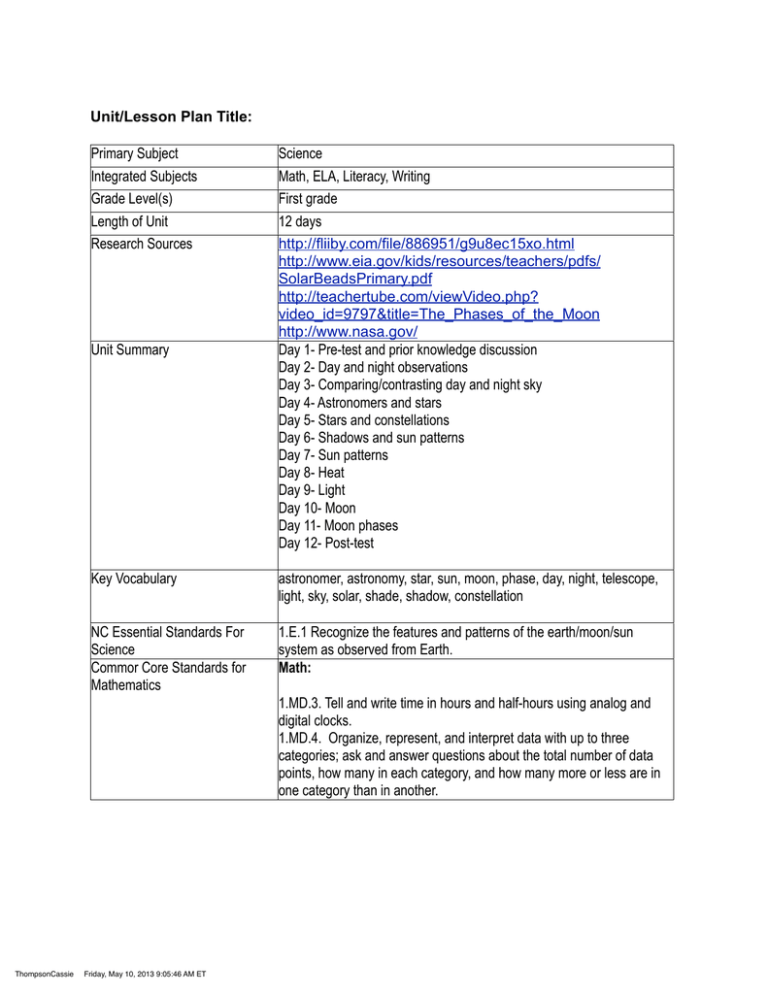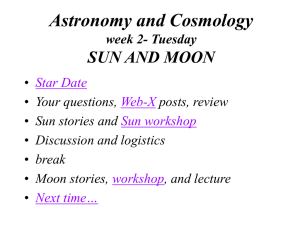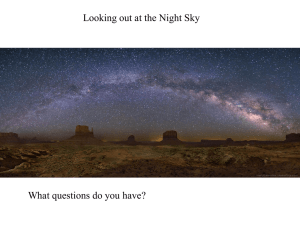Unit/Lesson Plan Title: Primary Subject Science Integrated Subjects
advertisement

Unit/Lesson Plan Title: Primary Subject Integrated Subjects Grade Level(s) Length of Unit Research Sources Unit Summary Science Math, ELA, Literacy, Writing First grade 12 days http://fliiby.com/file/886951/g9u8ec15xo.html http://www.eia.gov/kids/resources/teachers/pdfs/ SolarBeadsPrimary.pdf http://teachertube.com/viewVideo.php? video_id=9797&title=The_Phases_of_the_Moon http://www.nasa.gov/ Day 1- Pre-test and prior knowledge discussion Day 2- Day and night observations Day 3- Comparing/contrasting day and night sky Day 4- Astronomers and stars Day 5- Stars and constellations Day 6- Shadows and sun patterns Day 7- Sun patterns Day 8- Heat Day 9- Light Day 10- Moon Day 11- Moon phases Day 12- Post-test Key Vocabulary astronomer, astronomy, star, sun, moon, phase, day, night, telescope, light, sky, solar, shade, shadow, constellation NC Essential Standards For Science Commor Core Standards for Mathematics 1.E.1 Recognize the features and patterns of the earth/moon/sun system as observed from Earth. Math: 1.MD.3. Tell and write time in hours and half-hours using analog and digital clocks. 1.MD.4. Organize, represent, and interpret data with up to three categories; ask and answer questions about the total number of data points, how many in each category, and how many more or less are in one category than in another. ThompsonCassie Friday, May 10, 2013 9:05:46 AM ET Common Core Standards for ELA & Literacy ELA: R.I.7 Use the illustrations and details in a text to describe its key ideas. R. I. 10 WIth prompting and support, read informational texts appropriately complex for grade 1. S.L. 1. a. Followed agreed-upon rules for discussions b. Build on others’ talk in conversations by responding to the comments of others through multiple exchanges. . c. Ask questions to clear up any confusion about the topics and texts under discussion S. L. 5. Add drawings or other visual displays to descriptions when appropriate to clarify ideas, thoughts, and feelings. S. L. 6. Produce complete sentences when appropriate to task and situation. Essential Questions ThompsonCassie Friday, May 10, 2013 9:05:46 AM ET Writing: 2. Write informative/explanatory texts in which they name a topic, supply some facts about the topic, and provide some sense of closure. Day 1, 2, 3: Compare and contrast the day and night sky. Day 4: What is an astronomer? Day 5: What is a star? Day 6, 7: What changes do you notice about the sun? Day 8, 9: What do we get from the sun? Day 10: What is the moon? Day 11: How can you describe the changes you see in the moon? Materials & Resources Safety Requirements Activities/Procedures • Essential Question • Explore/Engage • Explain • Elaborate (Inquiry) • Evaluate Accommodations for Differentiated Instruction Cross Curricular Integration Created by Email ThompsonCassie Friday, May 10, 2013 9:05:46 AM ET Vernier Labquest Astronomy Lab Notebook Sun, Moon, and Stars flipchart supporting documents The Star Gift by Flavia Weedn Moonbear’s Shadow by Frank Asch The Moon by Melanie Chrismer (or access to Bookflix) solar beads pipe cleaners di-cut stars (150 for 25 students) Six 2-bar graphs incandescent bulbs CFL bulbs nightlights flashlights laser pointer black construction paper yarn Unit Vocabulary Cards see day-to-day instructions below Students will work in whole group, small groups, as well as with partners to enhance learning Hands on materials and inquiry based lessons Vocabulary is printed on cards that include pictures and written definitions Student notebooks can be modified using pictures rather than words Pre/Post assessment can be read aloud Document camera can be used when completing lab notebook Visual by teacher modeling, pictures, lab notebook, movie clips, and flip chart. Information and Technology1.TT.1.1 Use a variety of technology tools to gather data and information (e.g., Web-based resources, e-books, online communication tools, etc.). 1.TT.1.2 Use a variety of technology tools to organize data and information (e.g., word processor, graphic organizer, audio and visual recording, online collaboration tools, etc.). thompsoncs@rss.k12.nc.us; carterma@rss.k12.nc.us; lesleycm@rss.k12.nc.us Supporting Documents Teacher Notes, Flipcharts, Labs, Data Sheets, Rubrics, etc. Day 1 Administer pre-assessment multiple choice test. Also have students draw pictures in their Astronomy Lab Notebook of the sun, moon, star, and earth as part of an openended pre-assessment. Discuss the pre-assessment just to see what knowledge/questions students gained. Write down questions students have on an anchor chart. EQ: Compare and contrast the day and night sky. Create anchor charts on the flipchart as a whole group, “Daytime Sky” and “Nighttime Sky” of the children’s prior knowledge about what they observe in the sky. Pass out and explain the moon journal for homework. Students will observe the moon nightly during the unit, and they will color in the moon phase. (This is for a later discussion/lesson). Day 2 EQ: Compare and contrast the day and night sky. Students will use science journals to draw and write about their observations of the day and night sky. The students will go outside at three different times of the day during school. At each time, they will draw a picture and write about what they see and hear in the daytime sky. That night, the students will take their journals home to draw and write about what they see and hear in the nighttime sky. Day 3 EQ: Compare and contrast the day and night sky. Show the short film Day and Night by Pixar (5 minutes). (http://fliiby.com/file/886951/g9u8ec15xo.html). Discuss short film. Discuss observations from the day before. Discuss definitions for day and night. (introduce the vocabulary cards that contain each definition and display on a science word wall) Day is: The time that is light between sunrise and sunset. Night is: The time that is dark between sunset and sunrise. Students will write definitions in their science journals. ThompsonCassie Friday, May 10, 2013 9:05:46 AM ET Add to the anchor charts (if necessary), and then combine them to make a Venn diagram that compares/contrasts day and night sky on the flipchart. Copy Venn diagram into science journal. Day 4 EQ: What is an astronomer? Teacher will ask if anyone knows what an astronomer is. Tell students that they’re already astronomers, and they didn’t even know it! Explain definition of an astronomer to students. An astronomer is: a person who studies the day and night sky. (use vocabulary cards) Students will write definition in science journal. EQ: What is a star? Students will make predictions about stars by moving around the room answering questions (Question stem posters attached along with answers). They will graph their answers using die cut stars and place them under Yes or No after reading each question. They will then create a bar graph showing what they think prior to reading the story. After they have placed their star on the bar graph, they will record their answer that stems from the question in their science journal. Read The Star Gift by Flavia Weedn. After reading the story, refer back to the questions by visiting each bar graph. Was the students prediction right or wrong? They can then self assess by looking at their answers in their lab notebook. 1. Do stars fall from heaven and land on the ground? Answer: No. They are not solid like a desk or the floor. They are made up of invisible gases. 2. Could you possibly catch a star? Answer: You could not catch a star in an apron because most stars are huge. They just look tiny because they are so far away. 3. Are all stars warm? Answer: No. Stars are different temperatures. The hottest stars are blue but some others are white, red, or yellow-orange. It all depends on how hot they are. Stars are fiery hot balls of gas. 4. Do stars only come out at night? Answer: No. Stars shine all the time but during the day the light from the sun is so bright that the light from the stars cannot be seen so people might think they vanish. 5. If this is a story about the stars, what about the sun? Is the sun a star? Answer: Yes. The sun is a star. It is our closest star and looks like the biggest star because it is to close to us but it is only a medium-sized star. 6. Do stars really twinkle? ThompsonCassie Friday, May 10, 2013 9:05:46 AM ET Answer: No. They only seem to twinkle when we look at them from Earth. Day 5 EQ: What is a star? Teacher will refer back to the questions and answers that were taught in previous lesson pertaining to stars. Discuss the definition of a star. Students will write it in their journals. A star is: a distant point of light. (Show the vocabulary card) Use the flipchart to show that there are patterns in the stars. Show the constellation map and have students “connect the stars” in their journal to make the big dipper. Students can write the name and definition of constellation. A constellation is: a group of stars that forms a picture in the sky. (refer to vocabulary cards) Teacher will then have students view other constellations using images online. Day 6 EQ: What changes do you notice about the sun? Remind students that they learned the sun is a star. Have different size balls to have students guess how big they think the sun is. Tell students the sun is actually not the biggest star, but just the closest to the Earth. Go over the definition of a shadow. (use vocabulary cards) A shadow is: a dark shape made on the ground when you are between the sun the ground. Take the students outside in the morning and have them work in pairs to trace one person’s shadow. Mark the “model’s” heel with chalk on the ground. Then students will write a prediction in their science journals about what will happen to their shadows later in the day. Students will go back outside in the afternoon and re-trace. After the students re-trace they will record their observations and explain why they think their shadows are different. Teacher will model the concept of day and night using a flashlight and a student (then globe). As the flashlight shines, the student turns. Teacher emphasizes that we get light from the sun and that the EARTH rotates not the sun. Students will write the answer in their science journal about the earth moving, not the sun. ThompsonCassie Friday, May 10, 2013 9:05:46 AM ET Day 7 EQ: What changes do you notice about the sun? Read Moonbear’s Shadow by Frank Asch Talk about the pattern of the sun across the sky. Refer back to their drawings of the daytime. On the flipchart, have students move the sun to different times of the day. Have students sort photos. Show photos of sunrises, noon, sunsets, and night on the flipchart and have students sort. Students will draw pictures of four different times of the day (sunrise, noon, sunset, night) on white paper. They will cut out the illustrations and glue them in the correct order to a sentence strip. They will staple the sentence strip together to form a “sky patterns” headband to wear. Day 8 EQ: What do we get from the sun? Teacher will prompt students- What have we learned we get from the sun? What else do we get from the sun besides light? Students will use the Labquest to measure the temperature in the direct sun and shade. They will record their observations in their science journals. Day 9 EQ: What do we get from the sun? “I have these special beads that only change color with UV light. But you have to discover which source has UV light.” Each student will receive 10 solar beads and a pipe cleaner. They will put the solar beads on the pipe cleaner to make a “detector bracelet.” Students will test the beads under different kind of light (flashlight, lamp with CFL, lamp with incandescent bulb, overhead projector, laser pointer, nightlight, sunlight, etc.). Students will predict in their science journal whether or not their beads will change under the different sources of light. Then they will record their findings as they test each source of light. After students discover the beads only change under the sunlight, the teacher will explain that there is one type of light that we cannot see called UV or ultraviolet light. It is called ultraviolet because it is past violet on the rainbow. It only comes from the sun. Participants may know that UV light causes our skin to burn. If UV light is invisible, how can we find out more about it? Explain that scientists have built instruments that allow them to detect some kinds of light that our eyes cannot see, just like we built and used some personal UV light detector bracelets. UV light is: light that is beyond violet in the rainbow that we cannot see. http://www.eia.gov/kids/resources/teachers/pdfs/SolarBeadsPrimary.pdf ThompsonCassie Friday, May 10, 2013 9:05:46 AM ET Day 10 EQ: What is the moon? Refer back to “What Can We See in the Sky?” Venn diagram. Discuss the parts of the day and night sky of which they’ve already learned. Talk about the moon is the last thing in the night sky that we need to discuss. Ask students what they know about the moon. Have them refer to their moon journal they’ve been keeping at home. See what patterns they’ve noticed and what they think is happening to the moon. What do you think the moon is? Listen to Bookflix The Moon by Melanie Chrismer or another non-fiction book about the moon. Students will complete Moon tree map (is, can, has) in their science notebooks as the teacher does this on the flipchart. Day 11 EQ: How can you describe the changes you see in the moon? Watch “The Phases of the Moon” video clip. http://teachertube.com/viewVideo.php?video_id=9797&title=The_Phases_of_the_Moon Teacher will demonstrate the phases of the moon with a lamp and styrofoam ball. Students will be able to see the change in the reflection of the light on the styrofoam ball. Students will assemble moon mobiles (see moon mobile directions). Day 12 Review flipchart. Post-assessment Extension Activities Additional relevant literature: Stargazers by Gail Gibbons What Makes Day and Night by Franklyn Branley The Moon Book by Gail Gibbons - Use UV probes with same sources of light as used with the solar beads to compare the UV readings. - Place some solar beads in bags with different strengths of sunscreen to test UV protection. - Have children create a brochure about the importance of wearing sunscreen. - Oreo cookie moon phases http://www.sciencebob.com/blog/?p=828/ ThompsonCassie Friday, May 10, 2013 9:05:46 AM ET - Students can revisit their original drawings of sun, moon, star, and earth in their journals. Then they can draw again with their new knowledge and write about each term to display in the classroom. ThompsonCassie Friday, May 10, 2013 9:05:46 AM ET





